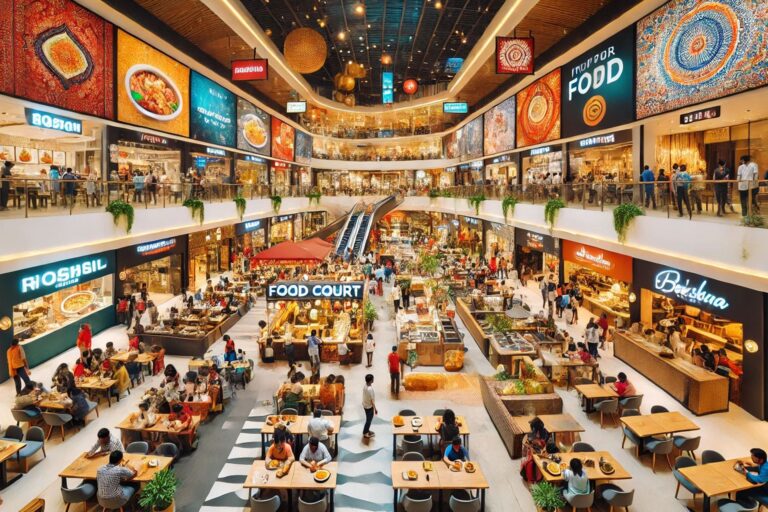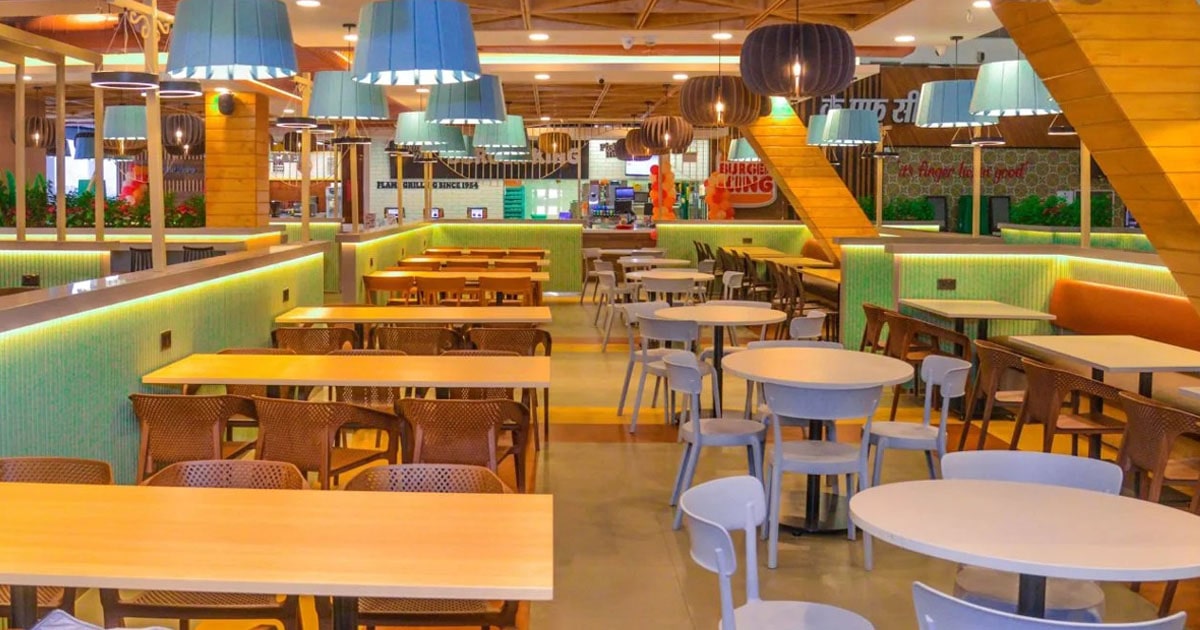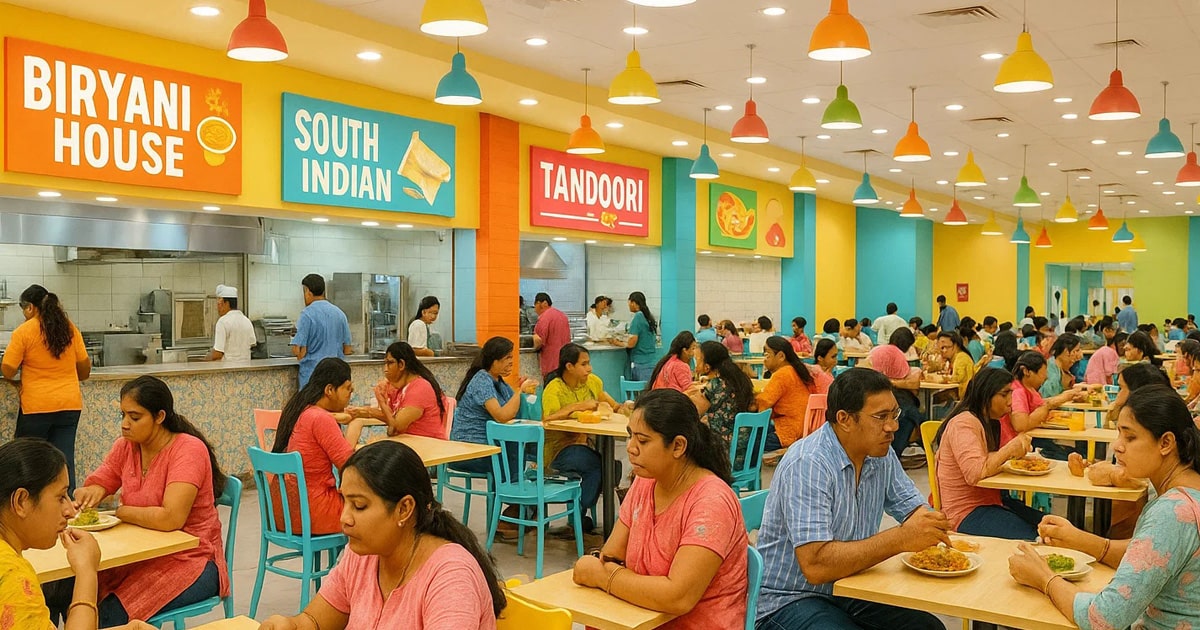Why Food Court Investment in India is a Hidden Gem
In 2025, food court investment in India is gaining popularity as a high-return, low-risk alternative to traditional commercial property segments. Food court investment in India is emerging as a hidden gem for investors, offering high rental yield, steady income, and long-term growth potential.
As more investors seek passive income through real estate, food court properties are emerging as the hidden gem of commercial real estate. Often overlooked, food court units are emerging as the dark horse of commercial property investment.
They combine the strengths of affordability, stable leasing, high footfall and low maintenance, making them an ideal choice for both first-time and seasoned investors. From Noida to Gurgaon and from Greater Noida West to the Dwarka Expressway, food court investment units are becoming an underrated asset class, delivering consistent rental yields and future appreciation.
Here are the top 5 compelling reasons why food court investment in India is the hidden gem of 2025.
Experience-Led Retail is Driving Food Court Demand
Why Food Courts Investment in India Are Thriving in 2025
In the last few years, Indian consumer behavior has shifted dramatically. Now, people no longer visit malls or commercial complexes to shop. They come for experiences including dining, entertainment, and social interaction. Food courts have become the centerpiece of experience-based retail. Whether it’s a quick bite, specialty coffee, or global cuisine, food courts appeal to all age groups and income segments.
Who They Attract
- Families prefer it for its variety
- Young professionals see it as a casual dining option
- Tourists and mall visitors use it as a resting stop
This broad consumer base ensures consistent footfall, which in turn keeps the food vendors profitable and secures rental income for property investors. In fact, in mixed-use developments and high-street projects, food courts often outperform showrooms in terms of engagement and dwell time.
The Reliability of Tenants and Assured Rental Yields
What Makes Tenants in Food Courts Attractive
One of the most significant advantages of investing in food court units is the strong tenant profile. Quick Service Restaurant (QSR) chains, such as Haldiram, Domino’s, and Wow! Momo, Barista, and Chaayos are rapidly expanding across Tier 1 and Tier 2 cities.
These brands:
- Spend heavily on interior and kitchen infrastructure
- Sign long-term leases (typically 5–9 years, which is suitable for investors)
- Prefer stability due to brand loyalty and operational setup
What It Means for Investors
- Rental security
- Fewer vacancy risks
- 6% to 9% returns per annum in many Noida and Gurgaon projects
Many developers are also offering pre-leased options and rental assurance schemes (fixed rent for 3–5 years), making it a ready-to-earn commercial asset from day one.
High Footfall Locations = Business Sustainability
Why Footfall Matters for F&B
Location has always been the golden rule in real estate, and when it comes to food and beverage (F&B), footfall is everything.
Most food court units are located within or nearby:
- Multiplexes
- Office towers
- Retail floors
- Transit points (like metro hubs)
This proximity ensures organic traffic. People already visiting for work, shopping, or movies naturally spill over into the food court, creating a steady customer base for tenants and a reliable rental flow for property owners.
Top Food Court Projects in 2025
- M3M The Line, Sector 72, Noida
- The Delhi Mall, Central West Delhi
- Group 108 Grandthum, Greater Noida West
- Bhutani City Center 32, Sector 32 Noida
- IRIS Broadway, Gurgaon
- Aarize The Tessoro, Dwarka Expressway
- The Omaxe State Dwarka
These projects are designed with strategic zoning and customer flow planning, ensuring maximum visibility and engagement for food court tenants.
Affordable Entry, High Liquidity
Investment Entry Point
A significant benefit of food court investment is its low-ticket entry. Unlike large retail stores or office spaces, which typically require ₹1–2 crore or more, food court units generally range from ₹40 lakhs* onward, with areas between 50–500 sq. ft.
This makes them:
- Accessible to first-time investors
- Attractive to NRIs looking for passive income
- Easier to resell due to high mid-range demand
Why Liquidity Will Rise
In a rapidly developing areas like Greater Noida West or Dwarka Expressway, capital appreciation is expected to rise significantly due to:
- Upcoming metro connectivity
- New residential townships
- The influx of corporate and IT population
This adds another layer of upside beyond just rental yield.
Low Maintenance, High Passive Income
Zero Operational Burden for Owners
Food court property owners do not operate the restaurant; instead, they lease the space to food brands or vendors who handle all the operational aspects, making it an ideal choice for those seeking a hands-off, yet profitable, investment. Investors are not responsible for day-to-day operations. Tenants manage staffing, kitchen setup, and maintenance, making it a hassle-free income opportunity.
- Staffing
- Kitchen setup
- Equipment
- Daily operations
- Maintenance of the unit
This makes food court properties an ideal choice for:
- Passive income seekers
- Busy professionals
- Senior citizens
- NRIs
Developer-Managed Food Court Zones
- The developer handles the leasing
- Vendors are curated for quality
- Owners receive monthly rental with zero involvement
It’s a stress-free real estate investment, a rare combination of income, appreciation, and hands-off ownership.
Bonus: Urban Expansion & Government Support
The food and beverage (F&B) sector is a critical component of India’s urban development plans. With initiatives like:
- Smart Cities Mission
- Metro expansions
- Tourism and hospitality infrastructure
…there is a significant government push to improve public amenities and lifestyle zones.
Food courts serve a vital need in:
- Transit hubs
- Tourist attractions
- Business parks
- Educational and IT campuses
This makes food court investment a future-proof assets aligned with long-term urban growth. In fast-evolving corridors like the Noida-Greater Noida Expressway and Golf Course Extension Road, food court are witnessing an increasing demand and vigorous leasing activity.
Final Thoughts: Why You Should Act Now
In the ever-evolving Indian real estate market, the best investments are often those others overlook. Food court investment properties are no longer just add-ons; they are becoming anchor assets in commercial ecosystems.
If you’re an investor who wants to:
- Earn stable monthly income
- Start small, scale fast
- Avoid operational complexity
- Enjoy long-term growth in NCR’s best locations
…then food court investment should be on your radar in 2025.
Read: Rental Property in India: Build Wealth With Rental Income
Explore, Compare, Invest Smart
At vikasjoshi.in, I help you navigate the most rewarding food court investment opportunities across Noida, Gurgaon, Greater Noida West, and Dwarka Expressway. Whether you are seeking pre-leased units, assured return models, or upcoming high-footfall commercial hubs, I provide expert reviews and insights to help you make smart, ROI-focused decisions.
Ready to invest in India’s booming food court real estate segment? Discover the top-performing projects and start your journey today. Call: +91-9811741277 | Email: hello@vikasjoshi.in.
Know More Before You Invest – Connect Now!
Read: What is Virtual or Non-Lockable Property
Frequently Asked Questions (FAQs) – Why Food Court Investment in India is a Hidden Gem
1. Is investing in a food court profitable in India?Know More Before You Invest – Connect Now!
Yes. Food court units in prime locations, such as Noida, Gurgaon, and Greater Noida West, are generating annual returns of 6% to 9% through rental income. With high foot traffic, reliable tenants such as QSR brands, and government-backed urban growth, food courts offer a profitable and low-risk commercial investment option.
2. What is the minimum investment required for food court investment property?
The minimum investment generally starts from ₹35–40 lakhs for compact food court units (50 sq ft. non-lockable), depending on the location and project. In premium projects, the price may range from ₹60 to ₹ 70 lakhs. It’s one of the most affordable entry points in commercial real estate.
3. Who are the typical tenants in food court properties?
Tenants are usually Quick Service Restaurants (QSRs) and local or branded F&B vendors, including:
- Domino’s
- Haldiram’s
- Barista
- Biryani Blues
- Chaayos
- Wow! Momo
These brands prefer food courts in high-footfall locations and typically sign long-term leases with investors.
4. Are food court investment units easy to resell in the future?
Yes. Due to their lower ticket size, strong demand, and high rental yield, food court investment properties enjoy good liquidity in the secondary market. They’re especially attractive to new investors seeking passive income with minimal management involvement.
5. How is food court investment in India is different from retail shop investment?
Food court units:
- Are smaller, more affordable
- Have higher footfall due to F&B demand
- Attract long-term tenants with operational reliability
- Are easier to manage, with lower overheads
In contrast, retail shops require higher investment, involve more tenant turnover, and may face more business fluctuations, especially in non-anchor zones.




2 Comments
Pingback: Rental Property in India: Build Wealth With Rental Income
Pingback: The Omaxe State Dwarka Review | Delhi’s 1st 5-in-1 destination